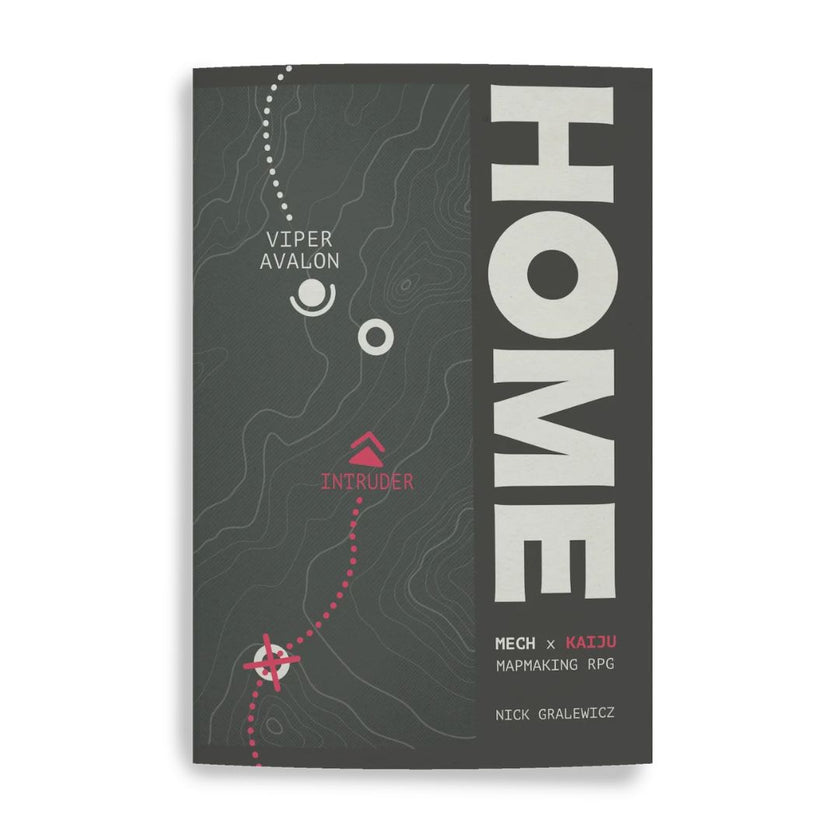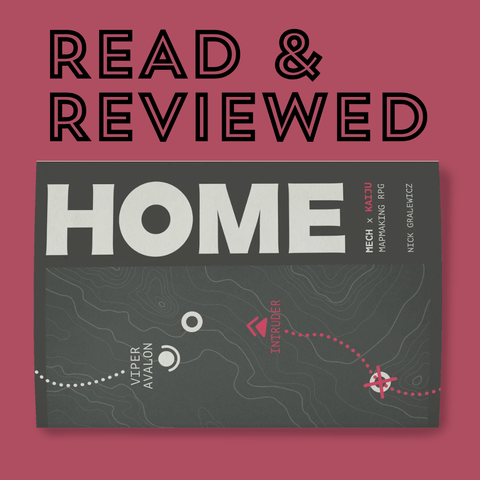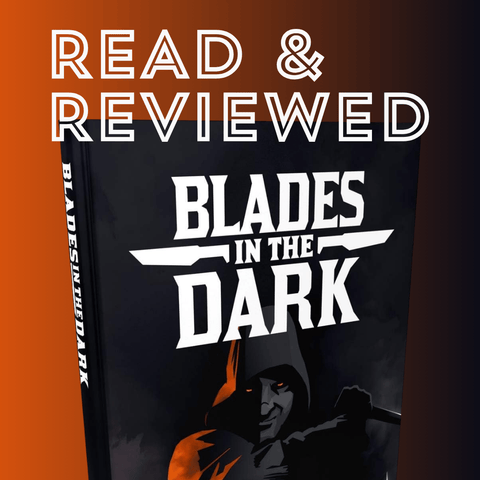by Christopher John Eggett
As the saying sort of goes, HOME is where you park your Mech. It’s also the place you’re defining and defending during this solo-to-four player tabletop roleplaying and map making game.

As with any ‘mecha game’ we’ve got an important bit of categorization to consider before we get into the complexities of bipedal weapons of mass destruction. The question is: is this an anime mech game or a flight sim mech game? Usually the first is mostly about characters, their connections and inner turmoil – the mechs and monsters are often metaphors for some great personal struggle. The latter is about the complexities of your cooling system going offline during an unpredicted solar flare, and having to reroute power from your shields to your main cannons. This latter category lives and dies on the cast-iron premise that ‘mechs are cool’.
HOME fits into the first category. We’re told early on in the 40 page zine that personal loss and mass destruction are on the cards during the game. In some ways, it’s guaranteed. The central call and refrain of the book is: what would you do to save your home? How far would you go to resist? When there is no hope left, would you hit the self-destruct button to protect those you’d leave behind?
This is, of all the sub-categorizations we can do, a ‘Kaiju anxiety’ game first and foremost. It’s a mecha-vibes game, rather than a crunchy Mechwarrior or Lancer. It’s about one really well defined moment in the history of a place, and it’s closer to Godzilla than anything else in tone. If Godzilla is about the nuclear bomb – the shame, the horror – then HOME is the ‘what if’ where you had a choice to fight back. The same thing is on the line.
And this is a collaborative attempt at survival – at the table and in-world – you cannot do this alone. There is no Superman here, and – we assume – that these giant mecha have been created through giant efforts on behalf of our nations. The chance for us to pilot them is also part of that effort.
You are not Superman, you are simply the bullet placed in the largest gun on earth in the hope that this weapon is the one to do the job.
So it’s fair that we take that seriously.

We are treated to a safety tools section up front, which suggests players turn things up or down, metaphorically. It’s not as clear cut as something like x-card, but it’s a good stab at making people aware they’re in control of the narrative.
And for a GMless game, control is a key aspect. Players are empowered by the game clearly from the get-go: you mostly know when to write and to draw, and it’s a painless process going from ‘what am I doing here?’ to scribbling on maps and jotting story fragments down.
The solo experience is elegant, as it’s the same as group play except a little faster, and you only have yourself to blame when the Kaiju rips off the arm of your mech and throws it towards your hometown.
Design wise HOME blesses us with a smooth ride. The information flow, hierarchy and design is top tier. Ideas are worked through quickly and in the order that they’re needed. There’s a good flow and the game loop is so clearly presented that you end up trusting the design quickly. Trust is one of the key ways that solo games can mess up – if a solo player can’t trust the book and rules they’re working with they’ll get frustrated, and they’re going to probably give up. HOME is a masterclass of answering the question the player is just about to ask.

It’s a beautiful looking game with stark, austere ‘information system as aesthetic’ vibes for much of the book. There is a tonal shift in the your mech playbooks that steps away from the seriousness and toward a more playful style, but the writing will carry you through to the same conclusions of personal loss, terrible defeats and pyrrhic victories. Later in the book, when we make Kaiju for our friends or ourselves, we’re presented with a more abstract representation of titanic killing machines – and this seemed more in keeping with the core vibe of the zine. It’s not about the big robot, it’s about – as the game reminds us – why you fight.
The core loop of HOME focuses on the building up of the atmosphere, sketching a background for your character and the preparations they’re taking before the fight. It’s light in what it asks from you, with sparse prompts that eschew any mundanity and instead make players focus on ‘what have you got to lose?’ We then spend some time preparing and scribbling our progress on our maps in whatever way is the most pleasing.
The Preparation phase is all about building a dice pool for the final encounter at the end of the chapter. The boon and bane dice pool system is meaningful, compact and fast. It puts weight on the preparation in a really satisfying way. Each preparation roll contributes the kind of dice (either positive O or negative ^) to the eventual showdown dice pool. When it comes to the ‘thumping each other at 100 miles above the city’ part of the game the ^ take away matching O rolls, possibly reducing your best roll – and the result of your aether cannons.
It’s a system that really connects into the core storytelling of the game – if your preparation leaves you with a mixed success, well that’s a great way to lead us toward a ‘yes, but…’ response in the journaling. It feels a lot better to monkey’s paw yourself when there’s a mechanic supporting that choice. And any solo game with journaling that can get away from the ‘isn’t this just a creative writing prompt?’ accusation is a relief.

One of my solo games leant toward conspiracy and searching for approval from my Connection – a main mechanic for making things personal in the game – the tension and costs were high, narratively. I was surprised how quickly the game drew this out of me. Its tone and sparse oracle quickly put me in a headspace where a mecha pilot could be hoping their sibling (deep within the clandestine bureaucracy) was watching her parade her big robot around on TV. Each mecha playbook will nudge you towards a different playstyle and a different kind of connection, there’s vast opportunity to explore any number of connections and homes through each of these lenses.
The use of the Connection here is the key emotional driver. It’s the chink in your armour that you allow, and it is how the story of the place you’re from grows. It’s deftly done throughout HOME and you’re regularly reminded to weave them into your story – what would you say to the person you think about the most before you head off to what is likely the end of the world? What can you say when, if you screw up, they might die along with the rest of the world? Unpicking questions like this, what the world and that person means to you is core to getting the most out of HOME.
Map making itself lends some scale to proceedings. You’re free to scribble what you need, but this rolls out slowly across the three missions contained in the book. At first your map will be minimal, sparse, an incomplete world with a few markers of your preparation. You’ll want to add arteries and blood to make it real from the start. But I advise you just trust the game, as the world you’re fighting for will reveal itself between the scars of battle.

One of the rewards for passing a mission is to build something, giving you a mechanical bonus to your preparation rolls. But maybe more importantly – something to lose if the Kaiju breaks through your defences. You scribble down your new outpost and suddenly it matters if you end up kiting a multidimensional beast east or west.
HOME has an important focus and a direction to it: we are already fully committed to what we’re going to do here. And as such, all of those arteries, all of that blood that I’m looking for are in the rearview mirror of history in this world. It’s irrelevant what’s going on down there for the most part because if this giant robot doesn’t punch the bad guy hard enough it’s all gone anyway.
This world, right now, might as well have already died. And if you win, you get to resurrect it.
In short: you are so doomed. So you might as well enjoy it.
HOME supports telling the story of the moment and its effects on what has come before, rather than worrying about what the entirety of the whole world looked like in the past and functions as today. This creates an interesting tension – you’re a little restrained as to when to add to the map in preparation, usually as part of a mission set up or reward you’ll add a few landmarks.
But during combat you’re encouraged to move the fight to a nearby grid square between individual attacks and combat scenes. This means the map is quickly littered with the wounds and bruises of your battles, radiating out from the Front at the centre of your map. It’s a cool effect, and leans perfectly into the forward-facing end-of-the-worldness of HOME. This tension is part of the drama – there is a complex enjoyment to choosing where to put your next upgrade. Choosing to place your research centre exactly next to where your last mech exploded, splatting Kaiju across the fields tells an entire story by itself.

Combat, the showdown that comes at the end of each chapter is narratively driven, with a single roll of a dice pool telling you how that exchange went. It’s a fast system that you can quickly feel yourself rushing towards once you’ve got the core loop identified – it’s the moment you’re here for right?
Except it’s not. The fights are often over quickly, brutally, with massive destruction. The stakes are high, but like every war – it probably comes down to a split second on the battlefield. HOME is not so much about being in a mecha and going to war, but about luxuriating in the anxiety that comes beforehand.
Once the dust has settled, you have a chance to freestyle an aftermath – before a new front or the finale. How does your home heal and how is it changed by your actions? It’s a question you could ponder, but truly, we’re at the credits and we’re already talking about our favourite parts of the film.
HOME is a contained, powerfully directed and perfectly built solo gaming experience. Where we’re asked to leap, we leap, and most of the time we stick the landing – thrusters engaged. This is a game powerfully committed to its vibe and unflinchingly sticks to it.
If you’re looking for a game that gives you a bold, cinematic experience, filled with deeply felt emotions, emergent storytelling and symbolism, HOME provides you everything you need from the inciting incident to the end credits.
A powerful meditation on place and loss in the shadow of choices already made.

Christopher John Eggett is a writer, editor and game designer from the UK. He was previously the editor of the monthly print magazine Tabletop Gaming. Chris and his partner make small solo and tabletop roleplaying games as Ada Press (https://adapress.itch.io/). Find him on BlueSky at @cjeggett.co.uk (https://bsky.app/profile/
© 2025 Tabletop Bookshelf





Comments (0)
There are no comments for this article. Be the first one to leave a message!